Episode 188: STS-106 - 2A or Not 2b (ISS Resupply 2A.2b)
Table of Contents
On STS-106, we finally get to meet Zvezda, the Russian service module for the International Space Station. We also meet some new faces, decrypt some mission designations, move a bunch of equipment, and perform an EVA that may or may not be a milestone.
Episode Audio #
Photos #
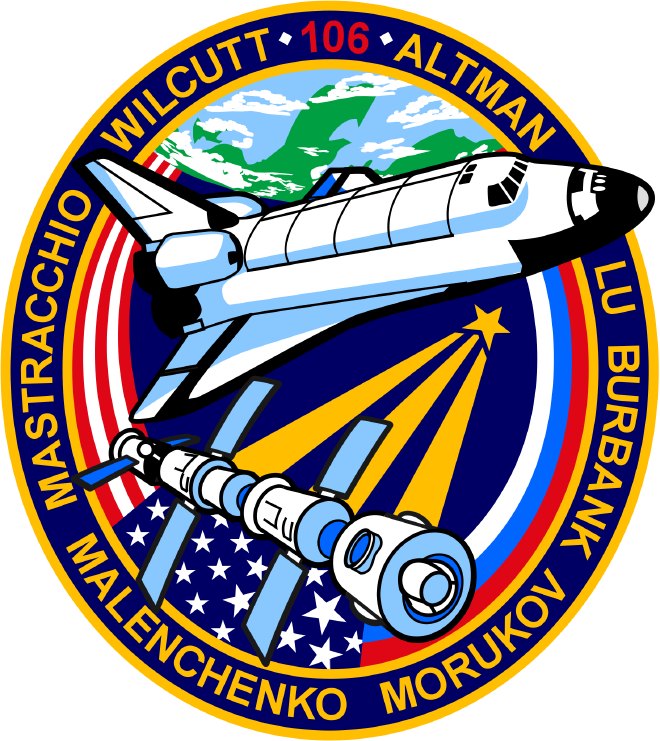
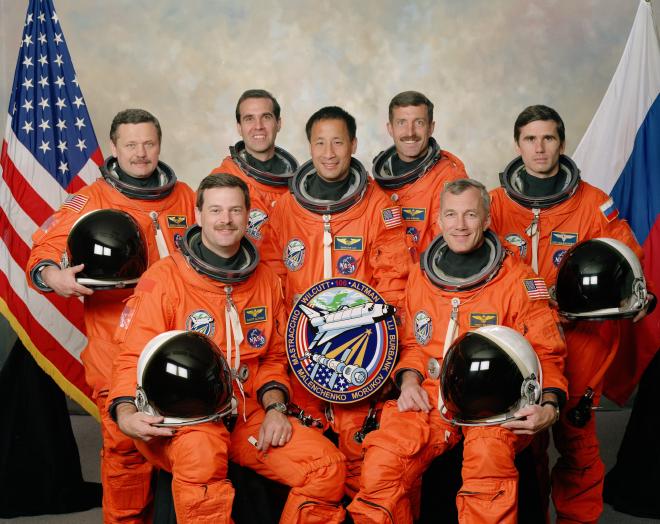
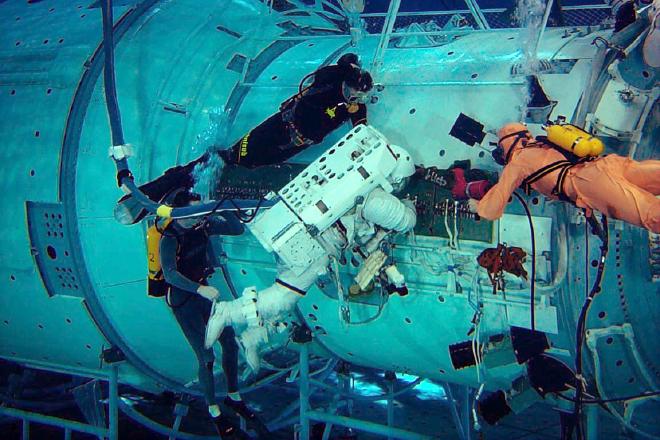

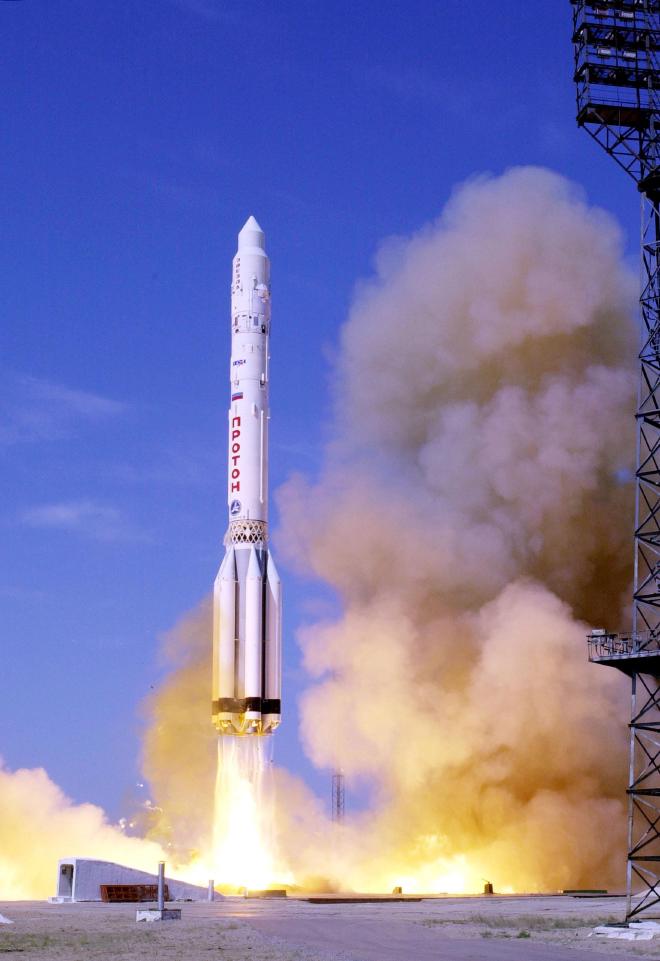
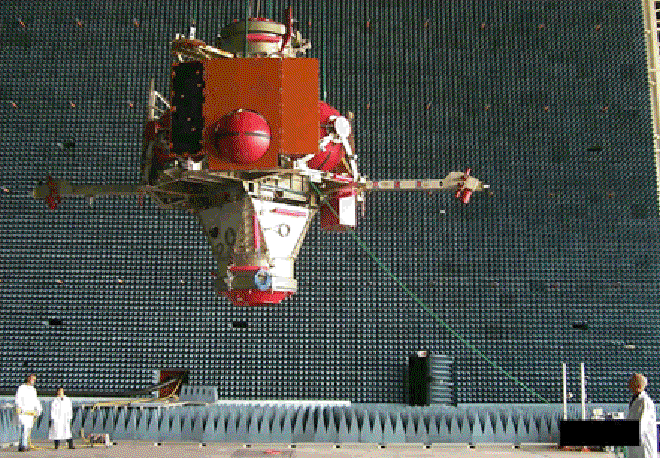

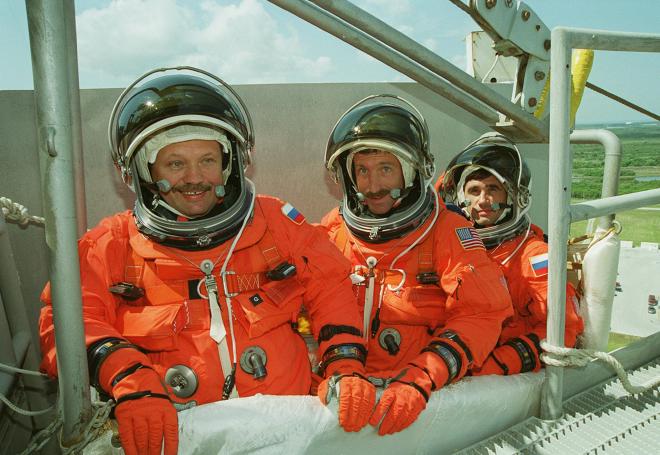
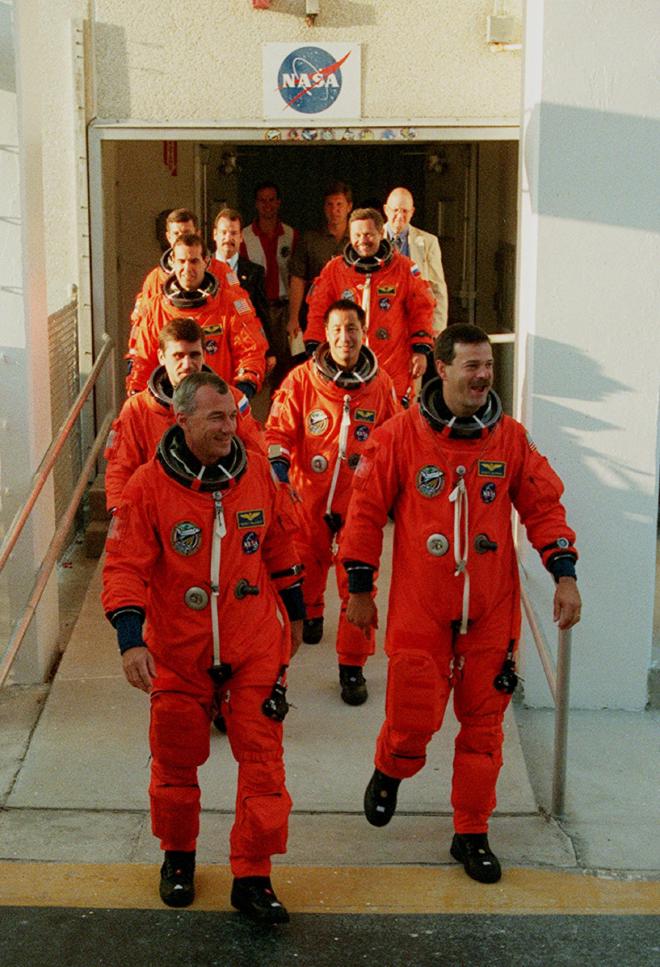


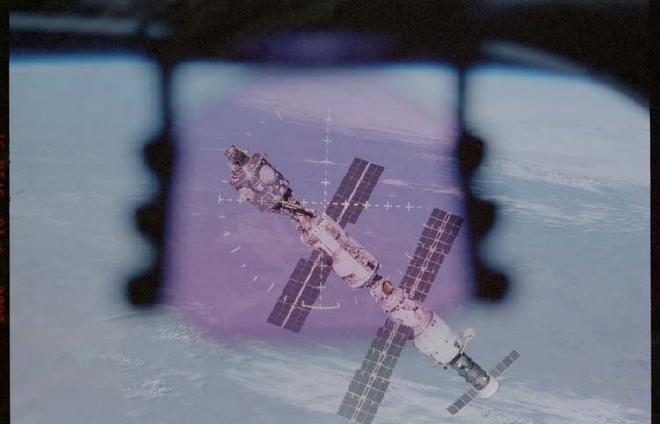
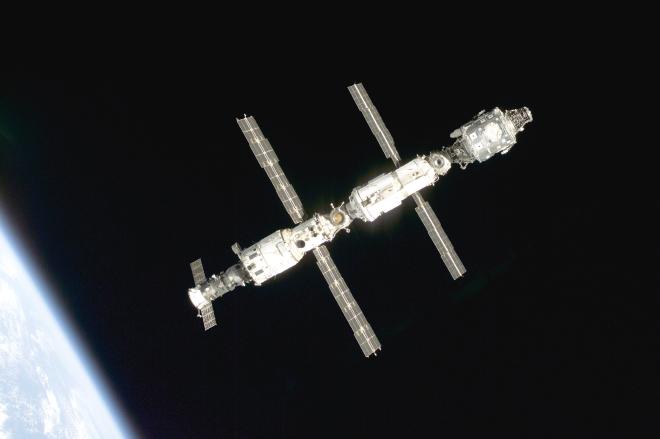

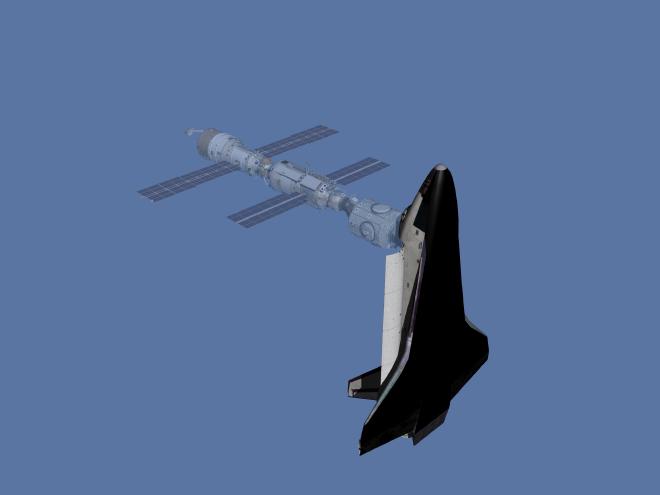
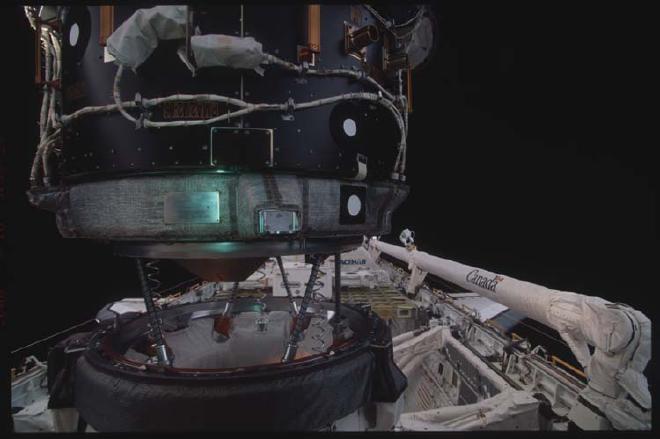
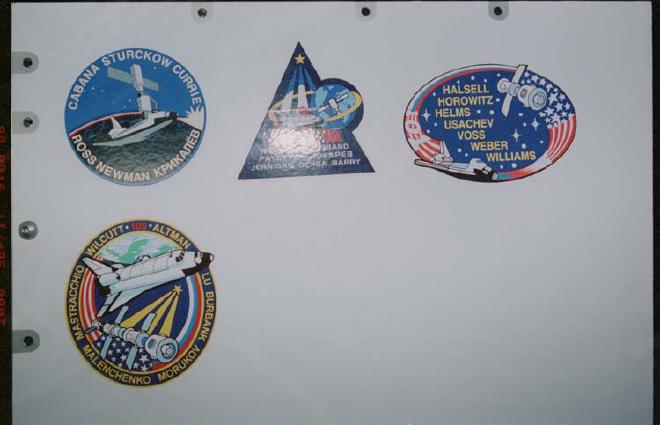

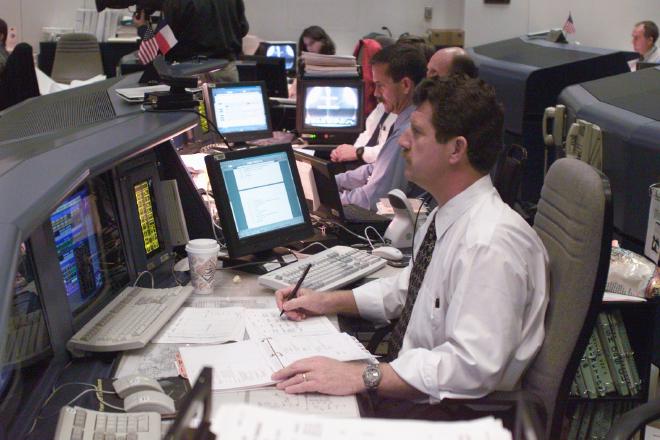
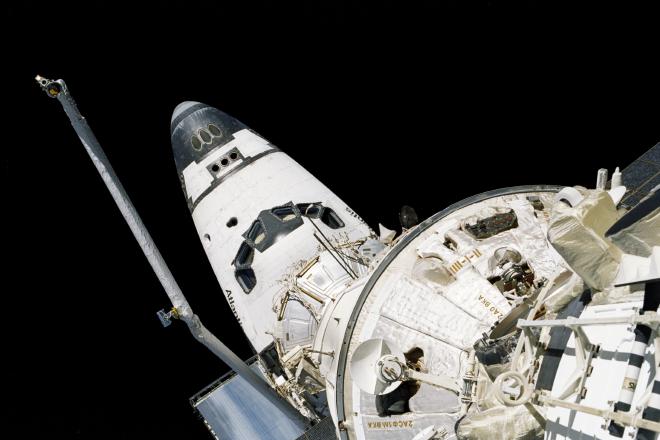
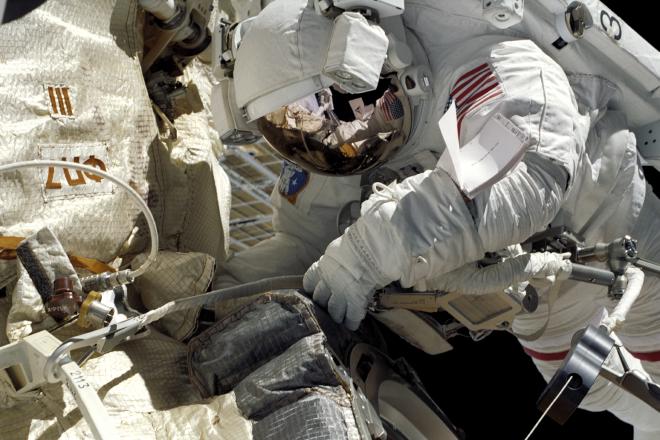

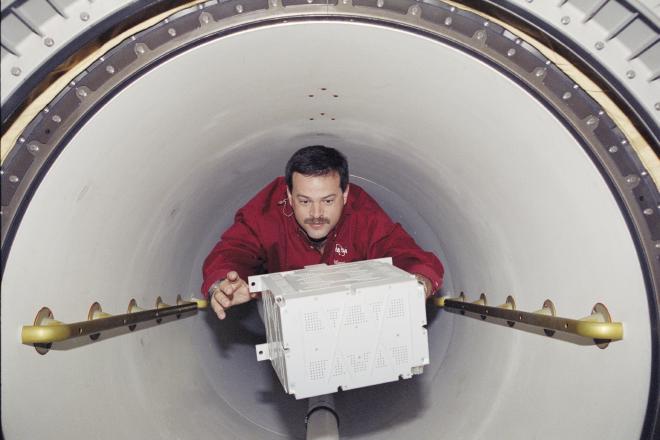
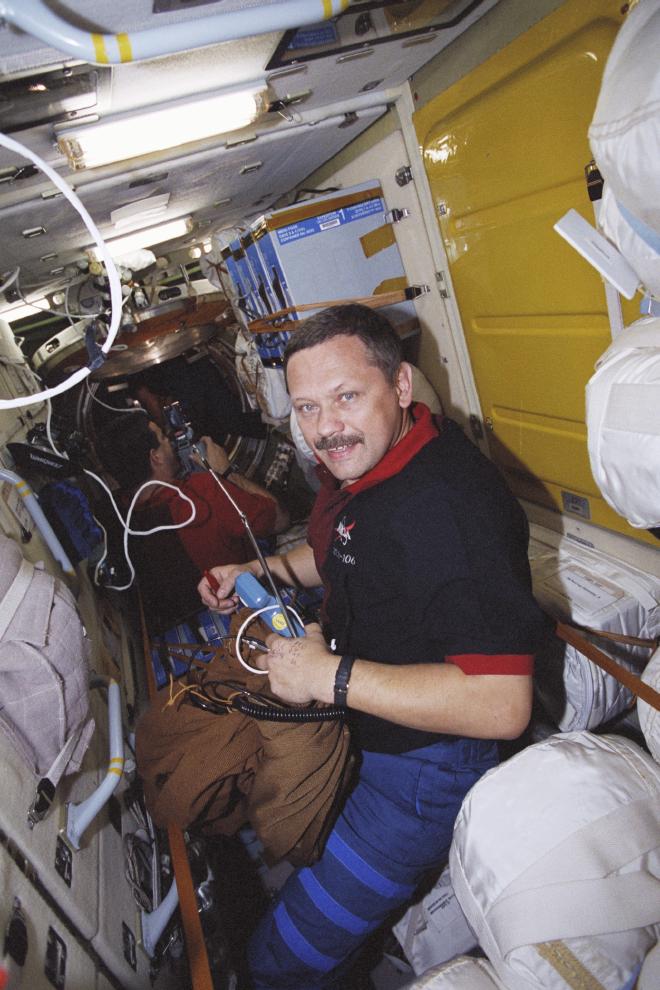
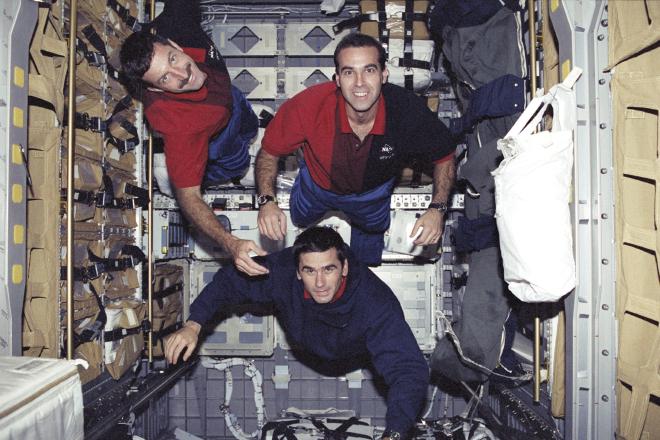

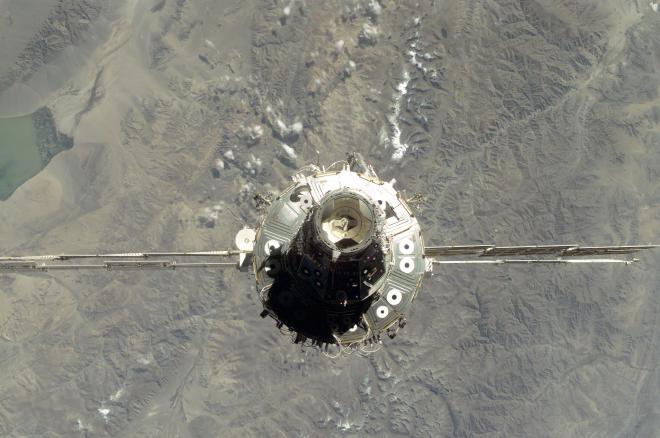

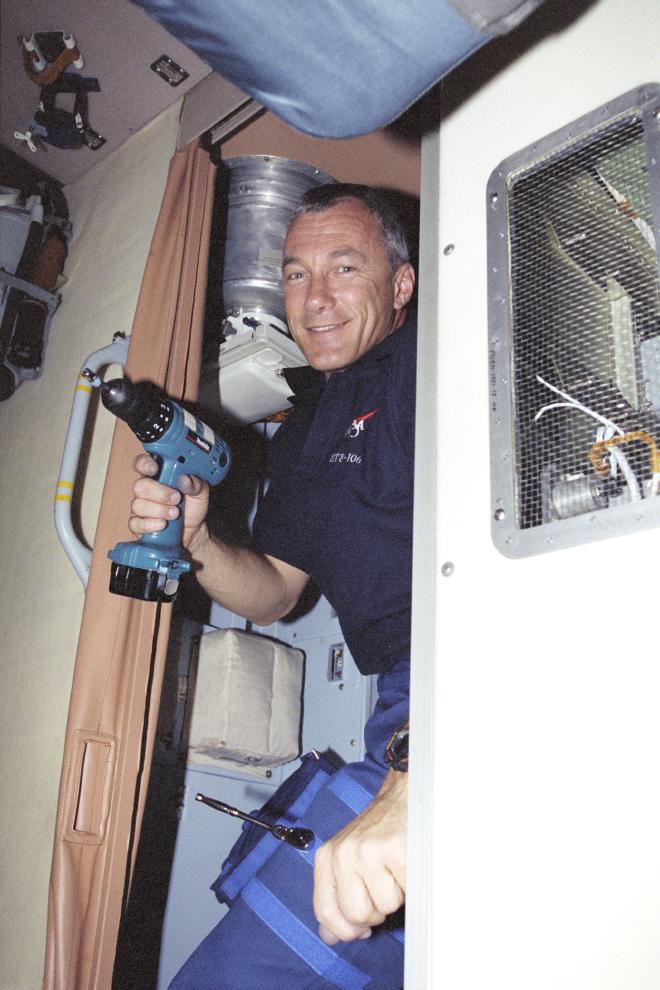
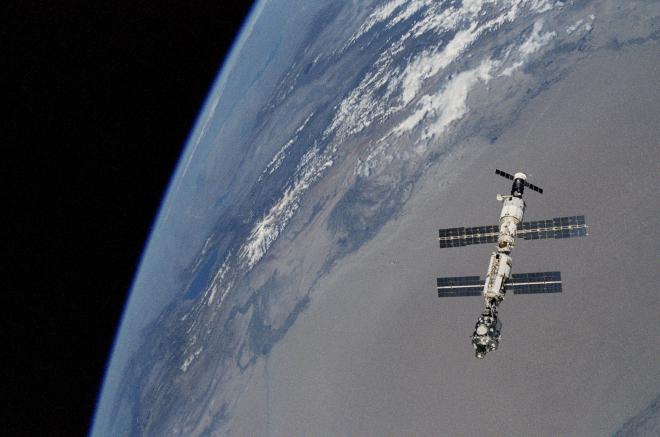
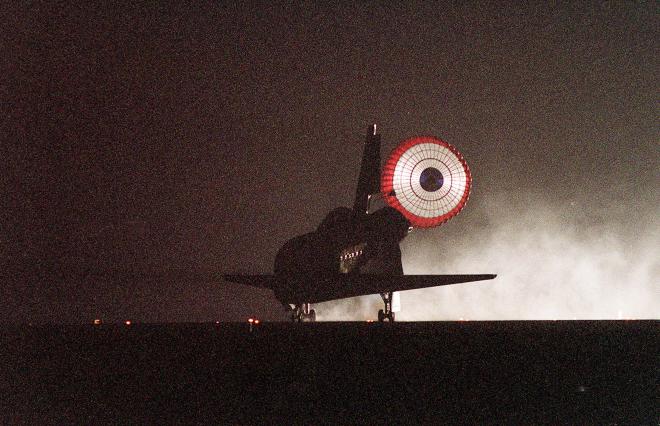
For more photos, head over to our friends at Wikiarchives.space: https://wikiarchives.space/index.php?/category/627
Post-Flight Presentation #
To see the mission in motion, check out the post-flight presentation!
Click here for full video details.
Transcript #
NOTE: This transcript was made by me just copying and pasting the script that I read to make the podcast. I often tweak the phrasing on the fly and then forget to update the script, so this is not guaranteed to align perfectly with the episode audio, but it should be pretty close. Also, since these are really only intended to be read by myself, I might use some funky punctuation to help remind myself how I want a sentence to flow, so don’t look to these as a grammar reference. If you notice any egregious transcription errors or notes to myself that I neglected to remove, feel free to let me know and I’ll fix it.
Last time, we took a quick break from the historical narrative to chat with former NASA flight surgeon Dr. Kim Broadwell. We learned about how astronauts communicate private medical problems to the ground, what the Shuttle first aid kit is called, and picked up some tips for enjoying a parabolic airplane flight. Today, we’ll pick up where we left off, with a mission that was the second part of the split-in-half STS-101: STS-106.
Before we dive into the mission, however, we have another bit of esoteric NASA nomenclature to learn about, which will also help explain the cryptic title for this episode. When we discuss Space Shuttle flights here on the show, we refer to their mission number, like “STS-106”. But when it comes to the Space Station flights, the ISS folks have their own mission designations. I suspect this was done in an attempt to decouple ISS objectives from individual Shuttle missions, which I suppose makes sense, but what we end up with is a mess that’s similar to when NASA decided to rename “STS-10” to “STS-41B”.
I should say at the outset that I have, somehow, been unable to find any official source that explains the nomenclature for ISS missions. Instead, people have been forced to just sort of reverse engineer it. Thanks to Jonathan McDowell for providing me his own understanding of how these mission names work and confirming what I had dug up. McDowell isn’t an official source, but he’s about as good as you can get for an unofficial source.
Before explaining the naming scheme with actual mission names, let’s explore the naming scheme with a simple example. Let’s imagine that the first ISS mission was flown by Japan. In that case it would be 1J. And then let’s say the next flight was Russian, getting us mission 1R. And then let’s say Japan did another mission, that would be mission 2J. So the scheme is basically a suffix denoting which country is flying the mission, and a prefix denoting how many missions they’ve flown.
OK, so far so good. But what about the first American mission? Well that would probably be named 1A, but there’s a wrinkle cause in reality the “A” doesn’t actually stand for “America”, it stands for “Assembly”. This is already confusing because from what I can tell, only NASA gets to use the “A” designation. Even if Russia adds something to the station, it’s still just an “R” flight. And later, NASA will fly missions they call “Utilization Flights”, “Logistics Flights”, and even “Utilization and Logistics Flights” with no clear rules for which is which.
Well now that we’re all thoroughly confused, let’s look at the first actual ISS mission: the launch of Zarya, the Russian functional cargo block. That must be mission “1R” since it was Russia’s first flight, right? Actually no. Remember, NASA funded and owns Zarya, so the first ISS mission is actually “1A/R” since it’s both an American and Russian mission. Also, the whole “A stands for Assembly” thing brings down right away because nothing’s really being assembled. OK fine. Next was STS-88 which launched Unity. This one actually sticks to the scheme no problem, since it’s denoted “2A”. It’s the second Assembly mission. Or American mission. Or whatever.
In the original plan, the next shuttle flight would have been ISS mission “3A”, delivering the Z1 truss, which we’ll talk about soon. But as we know, delays necessitated a few extra shuttle flights in between, starting with STS-96. Since this flight delivered a bunch of supplies and boosted the Station’s orbit, it should be the first Logistics Flight, right? Actually no, instead it’s 2A.1, I guess maybe to make it more clear that this is an added mission in between 2A and 3A. Next, we have STS-101, which was also added due to delays with the Russian service module, and thus flew before 3A. So this must be 2A.2, right? Close, but remember, the decision was made to split STS-101 up into two flights! So we take one more step down the nomenclature ladder and end up with 2A.2a, but with a capital A and a lower-case A. Ahhh, so now the name of this episode should hopefully make sense. Because following this crazy naming scheme, STS-106 becomes.. ISS mission 2A.2b.
So just to wrap all that up, the ISS missions so far have been:
- 1A/R: the launch of Zarya, which is funded and owned by NASA, but built and launched by Russia.
- 2A: the launch of Unity on STS-88.
- 2A.1: the resupply and maintenance mission of STS-96.
- 2A.2a: the resupply and maintenance mission of STS-101.
- 1R: the launch of Zvezda, which is inexplicably called 1R even though we already had 1A/R.
- And now, 2A.2b: the resupply and maintenance mission of STS-106.
I bet at this point you’re practically pining for the days of “launch site” and “fiscal year” based naming.
And speaking of numbers, we have another piece of business to attend to before we can continue. It’s time to introduce Astronaut Group 18! With Astronaut Group 18, aka The Bugs, we’ve got 17 more talented men and women to add to our cast. Everyone in this group will fly at least twice, so we will be hearing from them again soon. As usual, when introducing the whole class I’ll do my best on pronunciation but if I get it wrong, please shoot me an email so I can be sure to correct it for their first flight.
On the Pilot side we’ve got: Dominic Antonelli, Eric Boe, Kevin Ford, Ronald Garan Jr, Douglas Hurley, Terry Virts Jr, and Barry Wilmore.
And on the Mission Specialist side we have: Michael Barratt, Robert Behnken, Stephen Bowen, Alvin Drew, Andrew Feustel, Michael Good, Timothy Kopra, Megan McArthur, Karen Nyberg, and Nicole Stott.
This group has a bit of a wait in front of them, with the earliest flight being Alvin Drew’s flight on STS-118 in 2007. But a bunch of these folks are still active at the time of this recording, with Michael Barratt actually in space right now on Expedition 71.
Before we can get STS-106 off the ground, there’s one more critical thing to attend to: the launch and docking of the Russian Service Module for the International Space Station: Zvezda, or “star”. Given their continued use of the Soyuz to this day (as of 2024) it’s obvious that Russia is firmly in the mindset of “if it ain’t broke, don’t fix it” so it shouldn’t be a surprise that their core module for the ISS is the latest in a long line of similar modules for previous space stations. Once in position, it would provide living space, propulsion, power, and life support to the growing station, so it was of utmost importance that it arrive in one piece.
The module had been delayed for years by the shoe-string Russian space budget. It wasn’t that they didn’t know how to build it, because if there’s one thing Russia can do it’s build space station modules. But without money, things don’t get built. And then 1999 saw two failures of the upper stage of the Proton rocket, used for heavy Russian payloads. There was no backup Zvezda and Russia had no plan to replace it if something went wrong on ascent. So it wasn’t enough to just fix the problem with the Proton, everyone had to wait for a few extra successful launches to build up before such a precious payload could be risked.
The long-awaited day finally arrived on July 12th, 2000. And if there was any doubt about the dire financial straits the Russian space program found itself in, one only needed to look to the launchpad. Emblazoned partway up the 50-plus meter tall launch vehicle was a strange red vaguely trapezoidal shape accompanied by black text. The text read: Pizza Hut. It was the Pizza Hut logo. The Pizza Hut logo was on the rocket. Why?? Well.. Pizza Hut paid Russia around a million bucks to put their logo on the Proton rocket launching a crucial module to the ISS. I never thought I would be quoting the President and Chief Concept Officer of Pizza Hut on this show, but Mike Rawlings said “Our sponsorship of this critical mission tells consumers around the world that we’re always looking to take Pizza Hut innovation to new heights.” He went on to say he believes making great pizza is “rocket science” because it requires constant innovation, futuristic thinking, and a dedicated team effort to develop the world’s greatest variety of pizza. I mean, this is all pretty ridiculous, but I gotta give credit to Pizza Hut cause here I am 24 years later still talking about it.
Two weeks after lifting off, on July 26, Zvezda successfully docked with the ISS, connecting to Zarya. It was shortly followed by a Progress resupply vehicle which docked with Zvezda on August 8th, carrying a bunch of cargo we’ll talk about soon, as well as propellant to replenish Zvezda’s tanks. We’ll learn a little more about Zvezda later in the episode, but for now, let’s meet the crew that would be flying up to meet it.
Commanding the flight is Terry Wilcutt, who we know from a number of flights. Most recently we know him from STS-89, the final American crew swap on the Russian space station Mir. Today, with a visit to a different space station, Wilcutt ends his spaceflight career on this, his fourth of four flights.
Joining Wilcutt up front is today’s Pilot, Scott Altman. We know Altman from his role as Pilot on STS-90, the final flight of Spacelab. Of course, as I am contractually obligated to remind you, we also know Altman from his role as the real “Maverick”, flying the F-14 for the film Top Gun. This is his second of four flights.
Behind Altman is another familiar face, Mission Specialist 1 Ed Lu. We know Lu from STS-84, which delivered Mike Foale to and retrieved Jerry Linenger from Mir, making Lu another one of the small number of spacefarers to have visited more than one space station. This is his second of three flights.
Next to Lu is the first of four Space Shuttle rookies we’ll be meeting today. It’s been a while since we’ve had such a large batch of newbies! Newbie number one, and Mission Specialist 2, was Rick Mastracchio. Richard Mastracchio was born on February 11th, 1960, in Waterbury, Connecticut. He earned a Bachelor’s degree in Electrical Engineering and Computer Science from the University of Connecticut, a master’s in Electrical Engineering from Rensselaer Polytechnic Institute, and a Master’s in Physical Science from the University of Houston-Clear Lake. While earning that second degree, he applied to become an astronaut. He was rejected, but was offered a job at the Johnson Space Center, working on Space Shuttle software and procedures for ascent and entry. As the years ticked by he kept applying to become an astronaut and kept getting rejected, but made it further into the process each time. Finally, in 1996, after nine years of applications and making it to the interview stage three times, he was selected as an astronaut. This is Mastracchio’s first of four missions.
Moving down to the middeck, we find our next rookie, Mission Specialist 3, Dan Burbank. Daniel Burbank was born on July 27th, 1961 in Manchester, Connecticut but would tell you he’s from Yarmouth Port out on Cape Cod in Massachusetts. He graduated from the US Coast Guard Academy with a Bachelor’s in Electrical Engineering, and then joined the Coast Guard as a Deck Watch Officer and Law Enforcement and Boarding Officer on the Coast Guard Cutter Gallatin. From there he was sent to naval flight training, returning to the Coast Guard to fly and instruct on the HH-3F Pelican and HH-60J Skyhawk helicopters, in North Carolina, Massachusetts, and Alaska. Along the way, he also picked up a Master’s degree in Aeronautical Science from Embry Riddle Aeronautical University. He was selected as an astronaut in 1996 and has spent the last few years in basic astronaut training, working on computer displays and procedures for the ISS, and serving as CAPCOM. This is his first of three missions.
Our next crew member, Mission Specialist 4 Yuri Malenchenko, is a newbie to The Space Above Us but is certainly no rookie. Yuri Malenchenko was born on December 22nd, 1961 in Svitlovodsk in the Kirovograd region of Ukraine. Malenchenko graduated from the Kharkov Military Aviation School and spent the next few years in a variety of senior pilot roles in the Odessa Region. In 1987 he was selected as a Cosmonaut where he began basic spaceflight training, continuing on to more advanced classes and graduating from the Zhukovsky Air Force Engineering Academy. He was the reserve commander of the Mir-14 crew, the backup commander of the Mir-15 crew, and finally flew as commander of the Mir-16 crew, spending most of the second half of 1994 in space with our Shuttle-Mir buddy Talgat Musabayev. While on Mir, he worked with a familiar face, Ulf Merbold, who was there as part of the EuroMir program. Among other things, one claim to fame Malenchenko holds is being the first cosmonaut to complete a remotely operated manual docking of a Progress resupply ship. This is Malenchenko’s second of six flights, which will see him spend more than 827 days in space.
And last, but certainly not least, Mission Specialist 5, Boris Morukov. Boris Morukov was born on October 1st, 1950 in Moscow, Russia. He earned a doctorate in medicine from the 2nd Moscow Medical Institute and began working in space, aviation, and naval medicine at the Institute for Biomedical Problems, which is a great name. While there he earned a PhD, I think also in space, aviation, and naval medicine, because his official biography just says “received a PhD in the disciplines listed above”. He was selected for medical-cosmonaut service (which I think means he was a physician to the cosmonauts) and basically spent the next 20 years becoming one of the world’s foremost experts on space medicine, completing training on cardiology, gastroenterology, otolaryngology, stomatology, opthalmology, endocrinology, hematology, and CPR. In 1989 he was selected as a cosmonaut-researcher and underwent spaceflight training in between his continued work on research and experiments. This is his one and only flight.
One thing that’s worth pointing out about this crew is that about half of them trained for this mission on a compressed timeline. As we discussed in the STS-101 episode, the decision was made to split STS-101 into two flights, moving the crew members who specialized in Zvezda to STS-106. That meant that the new members of STS-101 had to train in a hurry, as did the members of the newly formed STS-106 who hadn’t just been shifted from STS-101. Commander Wilcutt said that they only had around six months of training instead of the usual twelve, requiring the crew (and their trainers) to put in six-day work weeks for a while until they could catch up. Despite this being Mission Specialist Mastracchio’s first flight, he said he wasn’t too worried about the shortened training flow. As we heard, he had been working at JSC for a dozen years at this point and had already been going through general astronaut training for three. So it makes sense that he was more than ready to go. There wasn’t a ton of time for more training anyway. The sun was at the maximum point of its 11 year cycle, fluffing up the upper atmosphere and increasing drag on the ISS, and there was a long line of assembly missions waiting to get started. So away we go.
While we’re here, I’d just like to extend another thanks to wikiarchives.space, who not only helps me find great photos to include on the show notes page, but also collects a large number of documents, including pre-flight interviews which helped me add some extra details to the crew biographies and stuff like Wilcutt and Mastracchio’s thoughts about the shortened training flow. If you haven’t checked it out yet, it’s definitely worth your time, and maybe a couple bucks as a donation! wikiarchives.space. Good stuff.
The Florida weather, our old adversary, tried to stop the launch before it even got going, with a lightning bolt striking the launchpad just three days before liftoff. But that big white lightning protection tower on the fixed servicing structure did its job, and there was no damage to the orbiter. In fact, STS-106 had a completely smooth road to orbit, sailing through a countdown that experienced no unplanned holds and lifting off right on time on September 8th, 2000, at 8:45:47am EDT.
As Space Shuttle Atlantis rose through an uneventful ascent, it’s worth taking a moment to reflect on the fact that the payload it carried to orbit was almost very different. Remember how I said that Russia had no backup plan if Zvezda failed to make it to the ISS? Well, that doesn’t mean that NASA didn’t have a backup plan. Always have a backup plan. Wary of the single point of failure that was Zvezda, especially when the schedule began to slip, NASA began considering the use of a device called the Interim Control Module, or ICM. The ICM was actually part of one of several proposals for Space Station Freedom, which NASA had been planning in the late 80s and early 90s. It was adapted from a Titan Launch Dispenser used on KH-11 reconnaissance satellites. I’m not using any primary sources for this, but from what I can tell, the Titan Launch Dispenser seems to be a funky little upper stage that’s little more than a bunch of propellant tanks and attitude control thrusters strapped to an engine. In order to turn the Titan Launch Dispenser into the Interim Control Module, some significant modifications would need to be made. It would need a smaller engine so it didn’t over-stress the ISS structure, it needed to handle operating without spin stabilization, its attitude control thrusters needed to be repositioned, and its software needed to be updated to handle a growing space station with a changing center of mass. Delivering the ICM would have been a very different mission, resulting in a very different space station, but since Zvezda did successfully launch and dock, it has been relegated to the pile of historical spaceflight “what-ifs”.
Atlantis, with a payload bay completely devoid of Interim Control Modules, arrived on orbit and the crew began to settle in for the mission. As always, the early tasks involved far-field rendezvous maneuvers, making sure the Canadarm robotic arm was working, and checking all their tools, equipment, and space suits. During this early phase of the mission, our first noteworthy issue popped up: the -Z star tracker wasn’t responding properly to bright light. The Space Shuttle Orbiter has two star trackers, with the -Z one being in the nose looking “up” from the crew’s point of view, and the -Y tracker right next to it, looking to the left. Star trackers are used to help determine the attitude of the spacecraft but can also be used in rendezvous since the target spacecraft will look a whole lot like a bright star until you’re very close. But they’re also sensitive instruments, so it’s important not to expose them to very bright light. In this case, the -Z star tracker wasn’t properly protecting itself from bright lights and wasn’t closing its protective shutter during daylight passes. Rather than risk further damage, the shutter was commanded closed and the rest of the mission was done using the -Y star tracker, requiring the crew to rotate Atlantis 90 degrees every once in a while during the approach.
When Atlantis arrived in the vicinity of the ISS on Flight Day 3, it was greeted by a very different station than what it left behind on the last mission. With the addition of Zvezda and the docked Progress, the station was now around 45 meters long. Or in the standard ridiculous comparison for my fellow Americans: around half a football field, nearly double what it was on STS-101. With Commander Wilcutt at the controls, Atlantis once again traced out a large semi-circle, passing from underneath the station to above it, before descending down the -R-bar, approaching the station from above. This maneuver made sure that the Orbiter wasn’t in between the ISS and Russian ground stations, ensuring smooth communication. Wilcutt would have been keeping a very close eye on his propellant usage during this final approach. There was plenty to ensure a capture, but the ability to perform a flyaround at the end of the mission depended on his conservation of limited propellant now. Once Russian ground stations made contact, Wilcutt moved Atlantis in for the final approach, with the Orbiter Docking System contacting PMA-2 at a relative velocity of around 2.5 centimeters per second. Later, as the ring retracted, there was a brief moment of misalignment as the high energy dampers began to disengage. But this was apparently an expected phenomenon, and once all the dampers disengaged the ring settled back into alignment. Atlantis was back at the ISS.
Later that day the crew briefly opened the hatch just long enough to grab an air sample from the ISS mating adapter, but then closed it back up again. There was other work to do before a proper ISS ingress. And that work was the 50th spacewalk from the Space Shuttle.. maybe. It’s complicated. The assertion that this upcoming EVA is the 50th from the Shuttle seems to depend on if we count the aborted EVA of STS-80, which depressurized the airlock but was ultimately unable to open the hatch. Or maybe you think that there was an EVA on the classified STS-27 flight, fixing an issue with the secretive payload, which has also been suggested. Or maybe you believe both, in which case we saw the 50th spacewalk on the previous mission. So let’s just say that this is the 49th, 50th, or 51st spacewalk from the Shuttle.
Whatever number it was, on Flight Day 4, Mission Specialists Ed Lu and Yuri Malenchenko climbed out of the airlock and got to work. Even ignoring the fact that this might be the 50th Shuttle spacewalk, this was a significant EVA since it was the first time that an American and Russian were performing an EVA together from an American vehicle. We’ve seen Jerry Linenger, Mike Foale, and Dave Wolf perform EVAs with their Russian colleagues, but that was all on Mir. So there’s another bit of spaceflight history trivia for you.
At the highest level, the goal for today’s EVA was pretty simple: connect some cables between Zvezda and Zarya, and install some equipment on the exterior of Zvezda. But of course, nothing can be easy in space. From the perspective of the crew on Atlantis, the ISS now towered above them, with PMA-2 sticking up out of the ODS, followed by Unity, PMA-1, Zarya, and then Zvezda waaaay quote-unquote “up” there. The Shuttle’s robot arm was only about 15 meters long, not even half the span of the expanded ISS. That meant that while the robot arm could give Lu and Malenchenko a head start, they were on their own if they wanted to get to Zvezda. In order to accomplish this, despite being Shuttle astronauts wearing NASA spacesuits, they would switch to Russian-style EVA procedures. In fact, as I mentioned two episodes back, the crew had even traveled to Russia to train for the spacewalk Russian-style. Commander Wilcutt pointed out that this was useful all on its own because it gave the astronauts more insight into the Russian training flow, and how their Russian colleagues approached problems.
So once at the maximum extent of the RMS, Lu and Malenchenko clipped safety tethers to the side of the station and began to climb up, translating along the exterior. Following Russian safety protocol, they kept two tethers engaged at all times, which involved a lot of backtracking. You’d unhook one tether, move forward, clip it in, go back, unclip the other tether, and repeat. All while being careful to avoid external equipment like antennas and while carrying bulky coils of cables. But before long, they were further from the Shuttle than any astronaut had been since the last flight of the MMU.
The first task was to connect nine cables between Zvezda and Zarya. Four of these allowed the Russian segment of the station to receive power from the upcoming American solar arrays. The Russian modules had their own solar arrays, but at certain parts of station assembly, under certain lighting conditions, the American arrays would shadow the Russian ones, so these cables allowed Russia to make up the power difference. Two more cables carried video signals from cameras on the end of Zvezda, allowing for monitoring of approaching Soyuz and Progress spacecraft. Another two cables allowed Zvezda to command Zarya’s solar arrays, pointing them where needed, centralizing control. And lastly, a fiber optic cable that would allow the transmission of Russian spacesuit data, I believe in the case of Russia EVAs from the upcoming Quest airlock.
Once the cabling was complete, Lu and Malenchenko began the long climb up to the far end of Zvezda. Once up there, they got to work installing a magnetometer on a two meter long boom. A magnetometer is just what it sounds like, it’s an instrument for detecting magnetic fields. And they’re pretty popular instruments to include on spacecraft in Earth orbit since the Earth has a handy dandy magnetic field. This means that if you measure the local magnetic field you can get a good idea of which direction you’re pointing, within a few degrees. For some applications, a few degrees of attitude error is catastrophic, but for keeping an eye on the health of the station it’s a handy tool to have available. But since the exterior skin of the ISS will develop a charge over time, the magnetometer needs to be physically separated from the rest of the station, hence the boom. What’s interesting about this is that Russia could have developed a boom that deployed itself. But with them being so strapped for cash and with two spacewalkers available anyway, they just stuck the magnetometer and the boom to the side of Zvezda for launch and Lu and Malenchenko installed it manually.
Magnetometer in place, Lu and Malenchenko carefully made their way back down the station, and soon were wrapping up the mission’s one spacewalk 15 minutes early, having spent six and a half hours outside.
On flight day 5, it was time to head inside. Once opening the various hatches between the shuttle and Zarya, the crew paused before opening the hatch into Zvezda and donned eye protection and breathing masks. After all, pretty much every new spacecraft in the history of spaceflight has launched with a few random bits of detritus floating around inside, and Zvezda was a new spacecraft. In a pre-flight interview, Commander Wilcutt said he intended to have his Russian colleague Yuri Malenchenko accompany him for the initial entry into the Russian Service Module. I couldn’t confirm if this actually happened, but it’s a nice thought, so let’s go with it.
Now that we’re finally inside it, let’s take a look around and see what, exactly, Zvezda actually is. Thankfully, for listeners of this podcast, there’s a good shortcut: Zvezda is more or less equivalent to the base block on Mir. It houses living space, control computers, life support equipment, and by the end of this mission, a toilet. So where Zarya plays a role sort of similar to Kvant-1, providing power and storage space, Zvezda is the primary Russian module of the ISS. If you were to ask Mission Specialist Yuri Malenchenko though, he would point out that while Zvezda is comparable to the Mir base block, there are differences. In a pre-flight interview, he pointed out that the onboard computers and motion control systems were updated from those on Mir. So it was essentially a modernized version of the base block we’re familiar with.
The structure has four docking ports. One is on the far end and is used by visiting Soyuz and Progress vehicles. The other three are clustered around the end near Zarya in a setup that is reminiscent of the Mir node, but without a left and right port. Put another way, there’s an axial port on either end of the module, with one for visiting vehicles and one permanently attached to Zarya, and then there are also ports on the top and bottom near the connection to Zarya. These radial ports were originally going to be used for the Russian UDM and SPP modules, but these were later canceled so we’re just going to skip over them for now. Lastly, on either side of the module were two large solar arrays, which made its combined width nearly thirty meters.
In all, the new module added around 13 meters of length and around 20 tons of mass to the growing space station. But as massive as that is, Zvezda was actually a little lighter than it needed to be. Put another way, Zvezda was launched in a not quite complete configuration in order to stay within the capabilities of the Proton launch vehicle. One of the primary tasks for the STS-106 crew would be to take Zvezda from its launch configuration to one that was ready to host a long duration crew in the near future. This was a pretty involved process. First, the crew removed a bunch of restraints that kept equipment in place during the launch, including stuff like fire extinguishers and gas masks. They also installed three large heavy batteries, which joined the five that had made the ride uphill inside the module. Also installed was a treadmill and associated vibration isolation equipment, an Elektron oxygen generating unit, Vozdukh CO2 scrubber, power conditioners for use with the American solar arrays, and the space station’s first toilet, among other things.
And Zvezda wasn’t the only module getting some attention. Even after the repairs done on STS-101, Zarya’s batteries and power conditioners still needed some work. Dan Burbank and Boris Morukov had trained for this task on the ground, but when they pulled up the FGB’s floorboards they discovered something unexpected. Right across their work site was a structural brace, blocking their access to the batteries and electrical equipment. The brace was held in place with large metal rivets that weren’t going to be easy to remove. But this is Zarya, the Russian segment, so fear not. Burbank and Morukov wrapped tape around the brace and the bolts to prevent creating any debris, and then used a chisel and sledgehammer that was inexplicably available, shearing the tops of the bolts off and opening up access to their work site. So I guess Lev was right and this really is how they fix problem in Russian space station!
All of these activities inside the ISS were sort of happening at the same time, with one constant being the shuffling of equipment from SPACEHAB on Atlantis, Progress at the end of Zvezda, and various nooks and crannies of the station. Boris Morukov was primarily responsible for unloading the Progress resupply vehicle, and Rick Mastracchio was primarily responsible for unloading SPACEHAB. Morukov pointed out that this was actually a pretty tricky operation. New supplies and equipment would be entering the station from two different directions and it was important to coordinate so as to not create traffic jams. Thankfully, most of the stuff in the Progress was headed for Zvezda, and most of the stuff in SPACEHAB was headed to Zarya, so keeping the streams uncrossed was not an insurmountable task. And once Progress was empty, equipment started flowing the other direction. Anything that was no longer required could be stuffed into the Progress, which would later burn up in the upper atmosphere. Some things were worth bringing home, such as the docking probe on the Progress, which could be refurbished and used again on future resupply missions, so they were transferred over to SPACEHAB.
Terry Wilcutt pointed out that this type of mission was actually significantly more difficult than the Mir resupply runs we’ve seen already, and the ISS resupply runs we’ll see in the future for one simple reason: there was no onboard crew. When there’s a long duration crew living on the station, the Shuttle crew just needs to deliver the equipment to them and they find the right place to store it on the station. But without a Station crew all the work of locating the right place and securing equipment there fell to the Shuttle crew. So it was a busy few days for the entire crew as thousands of kilograms of equipment were moved through the ISS’s hatches. Among the equipment transferred, those big heavy batteries, two Orlan space suits, the oxygen generator and CO2 scrubber, the treadmill, clothing, medical kits, personal hygiene kits, laptops, a color printer that definitely won’t jam I’m sure, vacuum cleaners, food warmers, trash bags, and 350 kilograms of water.
Among all of that equipment was one nondescript liquid nitrogen vessel that wouldn’t be worth bringing up except for two things: first, it fulfills this week’s quota on talking about crystals, and second, it is the first science experiment to be performed on the ISS. The Protein Crystal Growth Enhanced Gaseous Nitrogen Dewar was more or less what it sounded like. It was a specially constructed metal bottle that contained liquid nitrogen, which kept a bunch of protein samples nice and frosty. The dewar was designed to slowly let the nitrogen boil off, thawing the samples over the course of 12 to 20 days. We’ve seen similar experiments flown to Mir, but this one was extra smart since it has heaters and a thermometer in order to control the thawing rate. The resulting crystals will be picked up on the next mission, STS-92. So there you go, the first of many many experiments to come.
And while we’re on the topic of science experiments, I have another couple of goofy student experiments in the payload bay to mention. I know I shouldn’t make fun of these, because they truly are a really incredible service NASA provided to help inspire the next generation of scientists and engineers, but they were asking for it with some of these. Among the numerous student experiments tucked away on Atlantis was one which was studying the chewability of Bubblacious Bubble Gum, which makes me sincerely hope I’m about to get an email from a listener who got to chew some very stale space gum as a kid. And then my favorite in a while, and I’m quoting directly from the press kit here: An experiment labeled rubberball physics by its developers will try to determine whether space has any lasting effects on a rubber ball. This really cracked me up because for one thing, the title of the experiment isn’t even capitalized so it makes me think someone just dictated this over the phone. And second, while I’m sure a lot of thought went into it, it definitely looks like some kid suddenly remembered they were supposed to choose something to fly on the Space Shuttle and just pulled a bouncy ball out of their backpack. I look forward to future researchers combining these efforts and investigating the chewability of a rubber ball.
At the end of flight day ten, the crew closed up all the hatches and settled in for one last night docked to the ISS. The next day, Pilot Scott Altman took the controls, backing away from the station before completing two full revolutions around it, providing ample opportunity for photography. These photos are great for us space nerds but also served as a record of the state of the station over time. Once the second trip around the station was complete, Altman fired the thrusters for a 1 meter per second burn, and the ISS soon faded into the distance. Just over the course of this one mission it was a very different station than the one we left on STS-101. Suddenly it was starting to seem like a place humans could really live for months at a time. And to top it off, they even raised its orbit to 388 by 375 kilometers, leaving it close to the same altitude STS-101 had left it.
The STS-106 crew then enjoyed one day of free flight, moving further away from the station and making sure their spacecraft was ready for the big day tomorrow. On flight day 13, the crew suited up, pounded down some fluids to ease the transition back to gravity, fired the OMS engines, and soared through an uneventful entry and landing at the Kennedy Space Center. For those keeping track at home, this marks the 60th failed attempt at DTO 805, the crosswind evaluation. I’ll stop bringing it up every episode, but I’ll keep an eye on it so I can report any future successes. In all, STS-106 added 11 days, 19 hours, 10 minutes, and 56 seconds to Space Shuttle Atlantis’ running total, and it left the International Space Station in its best condition yet.
Next time.. we extend this metaphor too far as Discovery delivers the Z1 truss: the heart of the backbone of the station.
Ad Astra, catch you on the next pass.
